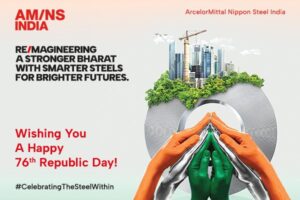- Essar also considers mining critical minerals for electric vehicle batteries and plans to expand renewable energy and green mobility solutions, such as LNG and electric trucks
- Essar will use 4.5 GW of renewable energy by a sister concern Essar Renewables to split water molecules to produce hydrogen and oxygen
- Essar Power expanding its 1,200 MW Salaya-DevBhoomi Dwarka thermal power plant by an additional 1,600 MW to meet Gujarat’s base-load needs
BUSINESS BUREAU
AHMEDABAD, JUNE 18
Essar Group aims to invest Rs 30,000 crore in a green hydrogen plant in Jamnagar, Gujarat over the next four years. The focus will be on clean energy for growth. Plans include decarbonizing the UK oil refinery, building a green steel plant in Saudi Arabia, and creating an LNG and electric ecosystem for long-haul trucks. Essar also considers mining critical minerals for electric vehicle batteries and plans to expand renewable energy and green mobility solutions, such as LNG and electric trucks.
“Essar Group plans to invest Rs 30,000 crore over the next four years in setting up a green hydrogen plant at Jamnagar in Gujarat as the metals-to-infrastructure conglomerate eyes clean energy as a key pillar for its new phase of growth. The conglomerate is looking to decarbonise its oil refinery in the UK, construct a green steel plant in Saudi Arabia, and build an LNG and electric ecosystem to decarbonise long-haul heavy trucks,” Prashant Ruia, director of Essar Capital, which manages the group’s portfolio of investments, said.
It is also considering an entry into mining of critical minerals, mainly used in electric vehicle batteries, solar panels and wind-turbine magnets. Essar Future Energy plans to develop 1 gigawatt of hydrogen capacity along with associated green molecules capacity of 1 million tonne per annum in Jamnagar over the next four years, he said.
“We are going to invest around Rs 30,000 crore (in the green hydrogen project in Jamnagar),” he said.
Essar will use 4.5 GW of renewable energy by a sister concern Essar Renewables to split water molecules to produce hydrogen and oxygen. Hydrogen, the cleanest known source of energy in the world, so produced can be used to power vehicles, generate electricity, power industry and heat homes and businesses. Hydrogen, which on burning produces only water, however cannot be shipped and is instead used to make green ammonia which can be easily transported.
“The idea is to create green molecules that can be transported directly rather than green ammonia. Because you carry green ammonia and then you convert it into hydrogen. That cost is very high. So we are trying to build a complex which can make green molecules from hydrogen and largely in the biofuels space and export that,” Ruia said.
The conglomerate, which turned debt-free in 2022 after selling some infrastructure assets, will expand its capacity to generate electricity from coal alongside building a renewable energy platform.
“The idea is to grow to about 10,000 MW over the next 3-5 years,” he said. This includes Essar Power expanding its 1,200 MW Salaya-DevBhoomi Dwarka thermal power plant by an additional 1,600 MW to meet Gujarat’s base-load needs. In the realm of green mobility solutions, Essar is focused on building an LNG and electric ecosystem to decarbonise long-haul heavy trucks, contributing to a cleaner transportation sector, he said. It has a fleet of 450 to 500 LNG-powered trucks that are used by different industries for their logistics needs, he said.
Trucks are the biggest polluters on the road, producing some 110 tonne of carbon dioxide per truck. There are 4 million trucks in the country and the number are slated to double in the near future. Replacing diesel in trucks with LNG, helps cut CO2 emissions by 30-35 per cent. Also, gas does not produce nitrogen oxides (NOx) and sulfur oxides (SOx) which cause acid rain and air pollution. Alongside, the group also has a fleet of electric trucks.
Emissions from electric vehicles are zero
“So what we’re trying, if you take the combination of the two you can reduce about 60-70 per cent of the CO2,” he said.
Essar is also building a retail network to supply liquefied natural gas (LNG) to trucks, he said adding LNG-powered trucks can run for 1,300-1,400 kilometers on a full tank while electric trucks have a range of around 150-km.
“So short-range is electric and longer range can be LNG,” he said.
Besides, the group is producing gas from coal seams from a block in West Bengal, he said.
Its arm, Essar Oil and Gas Exploration and Production Limited (EOGEPL), India’s leader in the coal bed methane industry, contributes nearly 65 per cent of the country’s total coal bed methane production and aims to increase its contribution to India’s total gas production to 5 per cent within the next five years.
Gas produced from coal-seams, called coal-bed methane, can be used as CNG for running automobiles as well as generating electricity and making fertilizer.
“We are today India’s largest CBM player. We do about a million cubic meters of gas per day which is very small,” he said. “Our idea is to grow that so we are investing Rs 2,000-3,000 crore to increase the gas-based portfolio.”
The firm is also exploring for shale gas in the Raniganj CBM block in West Bengal.
“India has not yet had a commercial success shale. We all know the revolution in the US because of shale. So we feel that there are some opportunities there. We are going to explore that… so please do not get excited yet but we are trying,” he said.












